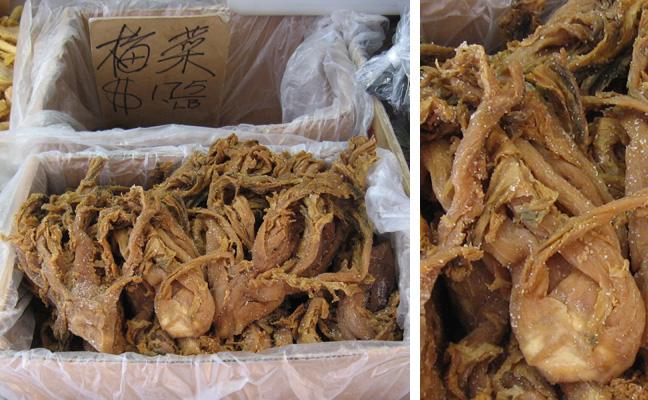Chinatown Mystery #5
By Dyske April 22nd, 2009

These look like squids at first, but then you notice that they don’t have any suction cups. And, I’m not sure if the sign behind them is referring to these or what’s at the bottom of the box behind it. Perhaps these are another seaweed?


Frank Luo says:
April 23rd, 2009 at 2:02 amThese are pickled vegetables. Called either 梅干菜 Maigancai or abbreviated as 梅菜 Meicai, literally “Plum-dried vegetables” or “Plum vegetable”, it’s a specialty of the Hakka, a Chinese subculture.
Typically made from Bok choy (a type of chard), rape (the vegetable from the seed of which Canola oil is made), or Chinese potherb mustard (Brassica juncea, commonly referred to as “mustard greens”), it is made by picking vegetables while they are still young and tender, at about 5-6 inches in height, then piling them up to deliberately wilt them, flipping them periodically so that they don’t accumulate bacteria and become compost, then salting the vegetables down and squeezing them as the salt helps break down the cells and draw out the water. After wilting, salting, and squeezing, the green vegetables lose all the chlorophyll and take on a yellow color. Then it is sealed up in jars and allowed to pickle for about a month, then sun-dried.
As one might expect from a pickled vegetable, it is salty and sour, with a pungent aroma. It is often used as an adjunct ingredient in stewed meats, because the acidicty and the pungent savory flavors balance the richness of the meat, and the vegetable itself offers a bit of contrast in texture. It is also popular in soups and steamed dishes — basically because the pickled vegetables are so pungent and strong in falvor, it is typically used in dishes that are cooked for a long time to allow the powerful flavor to leach out into the rest of the dish.
The most popular dish made with this pickled vegetable is 梅干菜焖肉 Meigancai Menrou, literally “pork steamed over a low flame with pickled vegetable”, where the pickled vegetable is cut into one inch pieces, and mixed with cubed pork (preferably pork belly i.e. bacon meat, with the rind still attached), soy sauce, spices, and sugar, and set aside to marinate. Once the pork has absorbed all the soy sauce, it is steamed over a slow flame for about an hour, by which time the pungent, sour, and salty flavor of the pickled vegetable has suffused the pork and balanced the fat content, in essence freeing the rich, sensuous mouthfeel of warm pork fat from the unpleasant greasiness that typically accompanies very fatty meat, and the meat has become chopstick tender, which is to say that the meat has become so tender that it can be easily bifurcated with a pinch of the chopsticks.
Julzh says:
April 23rd, 2009 at 9:47 amI already said, that Frank Luo knows everything.
Okay, I knew some things too.
But couldn’t give such good answers.
Frank Luo says:
April 23rd, 2009 at 12:54 pmI don’t know that much. I enjoy cooking and try to learn more as I go along.
These look a bit different from the Meigancai I used though… It could be that I am used to the Bok choy version of Meigancai, but these look more like 冬菜 dongcai “winter vegetables”, another pickled vegetable.
I’ll clear that up next time I am in Chinatown.
Steven Ripple says:
November 6th, 2009 at 7:34 pmBok choy is NOT chard, chard is the same species as beets, completely unrelated to Bok Choy. Bok choy is Brassica rapa – in the chinensis group (bok choy group). It’s the same species as Chinese cabbage, Napa cabbage, turnips, etc. Sometimes non-botanists especially on the web will call things chard, and these misnomers spread. In other countries the word chard is also used differently – and simply means ‘green leafy vegetable’ and may be another way this spreads, but this word then is useless in describing bok choy to someone, as it’s obvious it’s green and leafy.